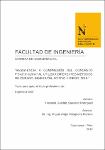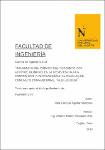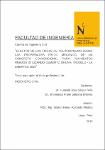Mostrar el registro sencillo del ítem
Resistencia a compresión del concreto F’C=210 Kg/Cm2 al utilizar diferentes métodos de curado: inmersión, aditivo y riego, 2016
| dc.contributor.advisor | Mosqueira Moreno, Miguel Ángel | |
| dc.contributor.author | Saucedo Rodríguez, Yessenia Gasdaly | |
| dc.date.accessioned | 2017-06-28T15:05:29Z | |
| dc.date.available | 2017-06-28T15:05:29Z | |
| dc.date.issued | 2016-10-31 | |
| dc.identifier.citation | Saucedo, Y. G. (2016). Resistencia a compresión del concreto F’C=210 Kg/Cm2 al utilizar diferentes métodos de curado: inmersión, aditivo y riego, 2016 (Tesis de licenciatura). Repositorio de la Universidad Privada del Norte. Recuperado de https://hdl.handle.net/11537/10530 | es_PE |
| dc.identifier.other | 624 SAUC/R 2016 | es_PE |
| dc.identifier.uri | https://hdl.handle.net/11537/10530 | |
| dc.description.abstract | RESUMEN La presente investigación se basa en el estudio de la resistencia a compresión del concreto aplicando diferentes métodos de curado, el concreto debido a su resistencia, versatilidad, durabilidad y economía del concreto, se ha convertido en el material de construcción más utilizado en todo el mundo, para alcanzar sus propiedades es necesario que tenga un curado adecuado. Inicialmente se determinaron las propiedades del agregado grueso y del agregado fino. Para la elaboración de las probetas fue necesario tener un diseño de mezcla por el método ACI 211, el cual se consideraron como un diseño patrón para todas las probetas, seguidamente se elaboraron las probetas de concreto en laboratorio, considerando diez probetas por método de curado que son: inmersión, aditivo, riego y sin curado. Se aplicará el curado de probetas de concreto a los siete, catorce, veintiuno y veinte ocho días. Luego que las probetas cumplen con los días de curado, se sometieron a ensayo de compresión axial donde se obtuvo datos de la deformación y de las cargas que se le aplicó a cada una de ellas. Con los datos de laboratorio se realizaron tablas de Esfuerzo vs. Deformación. Finalmente se determinó cuál es el método con mayor resistencia y en cuánto disminuyen la resistencia en base a un curado por inmersión. | es_PE |
| dc.description.abstract | ABSTRACT The current research is based on the study of the resistance to the concrete compression by applying different concrete cured methods. Due to its resistance, versatility, durability and economy, concrete has become in the most vastly used building material around the world lately. But to get all of these properties, it is so necessary for the concrete to have an appropriate cured method. The properties of both the thickness and flimsy aggregates were set up initially. To prepare the test tubes it was necessary to have a mix design by using the method ACI 211, it was taken as the pattern for the rest of the test tubes. Then the concrete test tubes were made at the laboratory, taken into account 10 by the concrete cured method that are: immersion, additive, irrigation and without being cured. The cured method on concrete test tubes was applied on the days 7, 14, 21, and 28. After the test tubes achieved the cured days, the axial compression was put into practice to get some data on the distortion and on the charges that were applied on them. With the lab data, the Effort Charts vs Deformation was made. We finally determine what the best method with higher resistance is, and in how much it reduces the resistance based on a cure method. | es_PE |
| dc.description.uri | Tesis | es_PE |
| dc.format | application/pdf | es_PE |
| dc.language.iso | spa | es_PE |
| dc.publisher | Universidad Privada del Norte | es_PE |
| dc.rights | info:eu-repo/semantics/embargoedAccess | es_PE |
| dc.source | Universidad Privada del Norte | es_PE |
| dc.source | Repositorio Institucional - UPN | es_PE |
| dc.subject | Resistencia a la compresión | es_PE |
| dc.subject | Concreto | es_PE |
| dc.subject | Resistencia de materiales | es_PE |
| dc.title | Resistencia a compresión del concreto F’C=210 Kg/Cm2 al utilizar diferentes métodos de curado: inmersión, aditivo y riego, 2016 | es_PE |
| dc.type | info:eu-repo/semantics/bachelorThesis | es_PE |
| thesis.degree.grantor | Universidad Privada del Norte. Facultad de Ingeniería | es_PE |
| thesis.degree.level | Título Profesional | es_PE |
| thesis.degree.discipline | Ingeniería Civil | es_PE |
| thesis.degree.name | Ingeniero Civil | es_PE |
| dc.publisher.country | PE | es_PE |
| dc.subject.ocde | https://purl.org/pe-repo/ocde/ford#2.01.01 | es_PE |
| thesis.degree.program | Pregrado | es_PE |
| dc.description.sede | Cajamarca | es_PE |
| renati.advisor.dni | 26733060 | |
| renati.advisor.orcid | https://orcid.org/0000-0003-2668-4909 | es_PE |
| renati.author.dni | 46687728 | |
| renati.discipline | 732016 | es_PE |
| renati.juror | Aguilar Aliaga, Orlando | |
| renati.juror | Ravines Azañero, Irene del Rosario | |
| renati.juror | Vásquez Sevillano, José Miguel | |
| renati.level | https://purl.org/pe-repo/renati/level#tituloProfesional | es_PE |
| renati.type | https://purl.org/pe-repo/renati/type#tesis | es_PE |
Ficheros en el ítem
Este ítem aparece en la(s) siguiente(s) colección(ones)
-
Tesis [1437]






